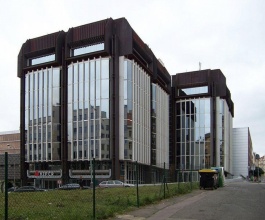
The ministry could decide on the fate of Transgas in about a month
Source
Matěj Říha
Matěj Říha
Publisher
ČTK
03.04.2017 07:55
ČTK
03.04.2017 07:55
Czech Republic
Prague
Václav Aulický
Jindřich Malátek
Ivo Loos
Jiří Eisenreich
Jakub Cigler
 |
Due to the possible demolition of the building, mainly opponents of new construction gathered today in the space of the former Federal Assembly, filling the hall where deputies once met. Before the lecture, a guided tour of the buildings took place, attended by several dozen people. "It is the work of four outstanding architects, and I believe that the works of outstanding architects should not be demolished," said architect Rostislav Škácha during the debate.
The work was created by the team of Jindřich Malátek, Ivo Loos, Zdeněk Eisenreich, and Václav Aulický. The buildings were built between 1966 and 1976. The complex of the former Central Dispatch of the Gasworks Transgas and the Ministry of Fuels and Energy stands beneath the Czech Radio building. Advocates for the protection of the buildings state that the work is one of the most significant realizations in the style of brutalism in the Czech Republic.
A petition against the demolition of the building has been created, with approximately 2700 signatures. If the organizers collect 3000 signatures, they plan to deliver the petition to Minister of Culture Daniel Herman (KDU-ČSL).
Developers anticipate that the building will be replaced by seven buildings, and a new public space with greenery, publicly accessible terraces, and barrier-free passage through the area will also be created. Restaurants with outdoor seating are also planned to be part of it.
Petr Herman, a representative of the development company, stated during the debate that this is a part of the city that is not living, and the buildings no longer serve the purpose they once had. "We will replace something that has no future with something that has a future," Herman said. He also noted that when the company purchased the building, it did not know it could get into such a conflict of opinions with the professional public.
The Ministry declined to declare Transgas a monument at the end of last year. The proposal to declare the buildings as a monument was addressed at the request of the Club for Old Prague, which disagrees with the decision and has appealed. Thus, the fate of the building should be definitively decided by the appeal commission, which, according to participants in today's meeting, will meet on April 13. It should then be clear whether the developer can demolish the buildings after obtaining the necessary permits.
Buildings from the second half of the 20th century are not often perceived by the public, and sometimes even by experts, as worthy of monument protection. Some buildings have been declared monuments after long discussions, such as the Prague department store Máj, while others have been rejected by the state for protection, allowing the owner to remove them. This is the case with the Liberec department store Ještěd, which originated from the same architectural studio SIAL as the Prague Máj.
Participants in today's debate frequently criticized the Ministry of Culture, which decides on monuments. "We are erasing a piece of history because we cannot protect it," stated well-known Prague rapper Vladimír 518, for example. Possible monument protection is also being considered or decided for other well-known buildings, such as the Kotva department store.
The English translation is powered by AI tool. Switch to Czech to view the original text source.
0 comments
add comment
Related articles
9
26.02.2024 | At the site of the former Transgas in Prague, construction could begin in the summer of 2025
1
03.12.2017 | SOS Transgas: protest against demolition
2
21.11.2017 | The Transgas buildings will not be a monument, and the owner can demolish them
0
01.10.2017 | The fate of Transgas will probably not be decided before the elections
1
10.05.2017 | Herman initiated a review of the decision regarding Transgas, it cannot be demolished
0
03.04.2017 | Architects want to declare the Parkhotel in Holešovice a cultural monument
0
30.01.2017 | Experts want to protect Transgas, the author of the building is against demolition
4
13.12.2016 | Transgas on Vinohradská Street in Prague is not a cultural monument
2
03.04.2016 | MK decides whether Transgas will be a monument on Vinohradská
0
17.03.2016 | The ugliest architecture in Prague - Transgas Building












